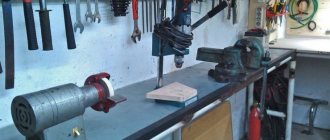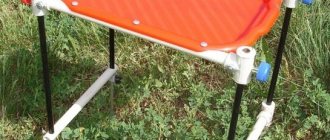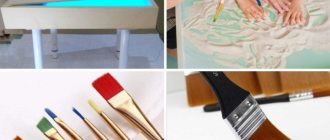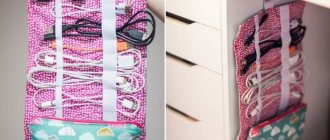A homemade fishing box made of plywood is shown in the drawing below, tested before painting. And I will continue the topic of making a fishing box with my own hands, designed for storing gear and fish caught during winter fishing.
A wooden plywood fishing container, like a homemade foam box, consists of two independent waterproof compartments. Fishermen who doubt the strength of a homemade foam box can make a box from plywood.
But I warn you, in a plywood box during winter fishing, the catch of fish caught, as well as the fisherman’s lunch, will freeze much faster than in a polystyrene foam box.
The drawings show a fishing box made of plywood and a pencil case in their original form before painting.
Painting after production will prevent the loss of the box during winter fishing in heavy snowfall or a blizzard for a fisherman who likes to check old holes.
Therefore, in order not to risk losing your homemade product in blizzard fishing conditions, I advise you to paint the top plywood of the finished box in a color contrasting with the snow.
Plywood ice fishing box
A homemade fishing box is glued together from multi-layer plywood, but the strength of the structure should be ensured by the slats glued into the corners. For this reason, 4-layer plywood is quite suitable for making a laminated wooden structure with your own hands.
A homemade box, conventionally made from 4-layer plywood without a pencil case, is shown in the drawing.
You can glue the box and the pencil case using the technology of making a foam plastic box for winter fishing with your own hands. Here I will give some tips related to the thickness of the walls of homemade plywood.
With an internal partition glued into the plywood box box, the design of the fishing box will be quite rigid, but rather heavy.
From the inside, along the perimeter of all compartments of a homemade fishing box, blocks with a square cross-section of 8 x 8 or 10 x 10 mm should be glued. When gluing the box, the plywood should be screwed to the bars.
The width of the thermos compartment is measured between the top bars, and not between the wooden plywood walls. Otherwise, your thermos will not squeeze into the compartment made for it.
DIY making
How difficult and labor-intensive it will be to make a fishing charabanc with your own hands depends on the skills of the home craftsman himself, the material and the complexity of the design. If you have enough free time, you can complete the task in 1-2 days.
Drawing of a universal box
To speed up the manufacturing process and avoid possible errors, it is recommended to initially draw up drawings of the future box. This can be done on simple notebook paper, or on a computer using a graphics program - for example, standard Paint.
A drawing diagram will help to anticipate possible errors.
The diagram of the future box should be drawn to scale. It should depict the model in three dimensions: from above, from the front and from the end side. The drawing should show all the main dimensions of the box - both external and internal compartments. When drawing up a plan, it will be possible to foresee all potential problems and difficulties, and find ways to solve them in advance.
Styrofoam
Polystyrene foam, also known as expanded polystyrene, is a very easy-to-process material that can be purchased at any hardware store. It is lightweight and has thermal insulating qualities. The only significant disadvantage of a foam box is its lack of strength. Therefore, to make a charabanc, you should take polystyrene foam with the highest rigidity index - extruded penoplex. For a medium-sized box you will need to purchase 2-3 sheets. In addition, you will need:
- "liquid nails" type assembly adhesive;
- hinges for attaching the cover to the body of the charabanc;
- self-tapping screws;
- metal corners for external fastening of joints of individual sheets;
- webbing straps;
- clasps or magnet to hold the lid in the closed position.
To assemble the structure, you will need a minimum set of tools: a jigsaw or fine-toothed saw, a screwdriver.
Wooden planks
Wood can be used to make a strong and durable fishing box. To do this, a rectangular frame is assembled from thin bars, which is sheathed on the outside with planks using self-tapping screws. To make the structure as light as possible, you should choose well-dried lumber. Lining slats, joined to each other according to the tongue-and-groove principle, are perfect. To give wood moisture-resistant properties, it is better to treat its outer and inner surfaces with water-repellent compounds - varnish or drying oil. After this, it must be thoroughly dried in an open state so that the chemical smell completely evaporates and is not absorbed by the caught fish.
If you or someone you know has scraps of laminate flooring lying around after a renovation, you can also use them to cover a wooden frame. Such a box will have a truly exclusive look. For the convenience of sitting in the winter frost, it is recommended to cover the outside of the lid with foam rubber, felt, and cover the top with durable fabric. Making a wooden charabanc will not pose any difficulties for an average home craftsman who is familiar with the basics of carpentry and joinery.
Plywood
Plywood is a very practical and convenient material for making fishing charabancs. To do this, you need to take a sheet or cuttings of a suitable size with a thickness of 5-10 mm. It is better if it is moisture-resistant or laminated plywood. Next, the sheet is cut in accordance with the drawing into blanks of the required size, which are fastened together. To do this, you can use the same self-tapping screws or wood glue. The outer part of the lid, like a wooden box, should be lined with warm and soft material for the convenience of sitting over the hole for many hours.
Duralumin sheets
Sheets of duralumin produce charabancs that are not afraid of moisture and are not subject to corrosion. Their disadvantage is low rigidity, so to make a duralumin charabanc you will first need to assemble a wooden frame. Then, using a grinder or metal scissors, the duralumin elements of the lining of the box are cut out, with which it is upholstered. The edges of cut metal blanks can be very sharp. Therefore, in order to avoid cuts when using the box, their ends should be rounded with a file.
Freezer compartment of an old refrigerator
One of the old ways to make a charabanc from scrap materials is to adapt the freezer from an old refrigerator. In this case, there is no need to assemble the body of the fishing box, since it is already completely ready. All that remains is to attach the bottom, lid and straps to it. For such a design you will need the following materials:
- for the body - a metal freezer taken from an old refrigerator;
- plywood sheet for the lid, bottom and internal partitions;
- foam rubber for padding the seat cover and leather, leatherette or fabric for covering it;
- hinges for attaching the lid;
- self-tapping screws
Since fishing gear in a metal box will rattle loudly with every step, it would be a good idea to line the inside with noise-absorbing material - fabric or a special film. The metal chamber is placed vertically on the plywood and its outline is outlined with a pencil - these will be blanks for the bottom and lid. Carefully cut them out and attach them to the camera on both sides. We screw the bottom tightly with self-tapping screws, and fasten the hinged lid with hinges.
Canister
Another quick and least labor-intensive option is to use an old canister of suitable volume for the charabanc. The upper part is cut off and a cover made of plywood or planks is attached in its place. To make a box, you can use both plastic and tin cans, for example, from machine oil. The disadvantage of this option is that the plastic is very fragile in the cold and can crack from the slightest blow. And canisters made of thin tin have low rigidity.
Battery case
Also convert the old battery into a fishing box. Here, as in the case of the freezer, some minor modifications will be required. To make the box spacious enough, you need to take a large battery from a truck. You will need to carefully drain the remaining electrolyte from the battery by unscrewing the caps, and then ventilate it from acid vapors.
Next, the upper part of the battery is evenly cut off with a grinder, the lead plates are removed, and the inside is thoroughly washed with a soda solution. Straps and a lid are attached to the resulting box, and if necessary, the internal partitions of the compartments are removed. The result is a fairly durable and compact charabanc, quite suitable for winter fishing for perch or roach.
Computer case
An old computer system unit can be converted into a box for ice fishing with some simple manipulations. For this you will need:
- two old system units;
- plywood sheet for the lid;
- foam rubber or felt, fabric for the seat;
- straps for shoulder straps.
All the internals are removed from the main block, and the top panel is also removed. The side tin panels are unscrewed from the spare unit and the casings for the ends of the main processor are cut out of them. The sheathing is mounted on rivets or metal screws. A plywood cover with a seat is attached to the top. The disadvantage of this design is the insufficient strength of the frame, which may not withstand the weight of a large fisherman and deform under his weight. Therefore, it is recommended to further strengthen the computer charabanc from the inside by inserting a plywood partition.
Large diameter pipe
For a winter fishing box, you can use a piece of large diameter plastic pipe. The result will be a roomy and lightweight charabanc, which, however, is not very comfortable for sitting above the hole. However, fishing gear, bait and catch can easily fit into it. A thick-walled PVC or polyethylene pipe with a diameter of 300-400 mm is ideal for making a charabanc.
A piece of the required length is cut from it, the lower part is covered with a plywood bottom, and a round lid is screwed to the opposite end. It turns out to be a box of vertical design, like a tube, which is convenient to carry on your back, like a backpack. Another option is horizontal, when the pipe is plugged at both ends, and a hole is cut in its central part for accessories and catch. This charabanc is worn on the side, on one shoulder.
Fishing box plywood thickness
You can choose your own thickness of the plywood walls of the ice fishing box box, but, in my opinion, 4-layer plywood is more suitable for making side walls with your own hands. Then your fishing box will not have too much weight and the homemade product will be strong enough.
The drawing below shows the components of a pencil box, also made of plywood, intended for storing fishing rods and gear for winter fishing. The dimensions of the length and width of the pencil case and the box of the fishing box should be tied together with fairly great accuracy.
You can make the lid yourself from plywood of the same design as on a homemade foam fishing box, that is, in the form of a pencil case. On this occasion I am drawing another drawing.
Suitable tools
It is worth taking care of the place in advance. For example, you will most likely have to work with glue and varnish. You will need to set up a table, cover it with papers and oilcloth. To make a fishing box with your own hands you will need a set of tools:
- Hammer;
- Nails, screws, rivets;
- Pliers;
- Screwdrivers;
- Ruler;
- Level, etc.
It is important not to forget about safety precautions. For example, gloves and a respirator may sometimes be needed.
Homemade fishing box with plywood pencil case
The grooves for the movement of the lid of the fishing box pencil case should be formed between two narrow wooden blocks with a cross-section of 5 x 5 or 6 x 6 mm glued parallel to the side walls of plywood. That is, as shown in the drawing.
The cover of a pencil case for storing and carrying gear during winter fishing, which is also a fisherman’s seat, can be made with your own hands either from 4-layer plywood, or from sheet getinax or textolite.
Before going on winter fishing, the plywood of the finished box should be soaked in drying oil and painted.
I do not recommend cutting holes in the wall of a plywood box, like a foam plastic box, for throwing caught fish into a wooden container.
Otherwise, in the frosty conditions of winter fishing, you will quickly freeze your fish catch, just like you freeze your lunch, and also significantly cool the contents of the thermos.
It’s better not to throw the caught fish into the snow, where it will freeze in the shape of the letter “zyu,” but to put it in a fishing pouch. You will also place frozen fish from it into your plywood box, but in an elongated state. In this form, more of it will fit into your fishing box for winter fishing.
You can see an analogue of a plywood fishing box on my YouTube channel in a video called Homemade fishing box. Only it shows a newly made box not made of plywood, but of polystyrene foam.
All articles and inventions on the site, many of which have been tested and tested in winter fishing for at least fifty years, are copyrighted. So, I think you won’t have any difficulties.
Advantages and disadvantages of homemade boxes
Homemade charabancs have a number of advantages compared to those sold in specialized stores.
- Each fisherman will be able to independently make a box that best suits his needs and aesthetic needs. This includes the volume of internal space, the number of partitions, and the external design.
- A charabanc made from scrap materials will cost much less than a factory one.
- If necessary, it is possible to modernize a homemade box, bringing it to real perfection. There are designs with spinning rod holders, with external suspension points for fishing accessories and ammunition, etc.
Homemade box with soft seat
- High suitability for repair. In case of breakdowns, a homemade charabanc can be repaired with a minimum of time and effort.
The shortcomings of do-it-yourself fishing boxes, if any are identified, can be quickly eliminated through minor alterations and design improvements. Thanks to this, homemade modifications of charabancs continue to remain popular among experienced fishermen, despite the large number of factory models offered in stores.
Box hinges for ice fishing
A homemade fishing box made of plywood is made with a folding pencil case. When making a box for winter fishing from plywood, the lid-pencil case can be made hinged on two regular hinges.
When closing the box, the perimeter of the pencil case should fit snugly to the perimeter of the box. The guides of the lid of the pencil case should not rest against the partitions glued inside the box.
As for the homemade fishing box made of polystyrene foam, I would recommend fastening the box of the foam plastic fishing box with the pencil case using a piano hinge for strength. You understand that polystyrene foam is not the most durable material in the world.
Yes, and sometimes we transport boxes to winter fishing and back, not in the best conditions.
A piano hinge would not interfere with a box glued together from plywood, given the small width of the blocks glued along the perimeter. Or, to attach it to the pencil case box, glue one block wider.
Charabanc from a canister! The fastest, but not the most reliable option
“I made it in an hour in the garage as a temporary replacement, I’m still using it”
Advantages of this model: it would be superfluous to talk about reliability here, but the ease of execution and low cost of materials still made this charabanc very popular. It is light, practical and roomy. However, in severe frost it can crack and this is its only drawback.
Materials:
- Large size canister for drawer body
- Small canister for sections
- A piece of plywood for making a seat
- Insulation (foam, polyurethane foam)
- Waterproof durable fabric
- Staples for construction stapler
- Screws
- Hinges
- Plywood to strengthen the structure from the inside and internal sections
- Fiberglass and epoxy glue or aluminum corner 4*2 to strengthen the edges of the canister.
Tools and fabrication:
Everything is extremely simple. We take a large canister, determine the height of the future box and cut it evenly. We cut the small canister so that we get two side patch pockets. They can be attached to the main structure using a construction stapler. It is better to make the lid from plywood. Insulate it well and wrap it in durable fabric. However, before installing it, you need to secure the edges of the canister. To do this we need fiberglass and epoxy glue or corners. Inside we install sections of plywood; in addition to their main function, they will also act as a frame and further strengthen the structure.
The tools you will need are: a jigsaw/saw, a construction stapler or its equivalent, scissors, a screwdriver.
Advice: never forget that this structure may not withstand severe frost and crack at the most inopportune moment. Try insulating the charabanc from the outside .
Painting a winter fishing box
If you paint a homemade winter foam box in a color that is noticeable in the snow, you can go fishing tomorrow. I can advise you the same way about painting a homemade plywood box.
And, if you paid attention to this, metal corners are glued to the lower corners of my fishing foam boxes and then secured with short screws.
To increase strength, all walls of the winter fishing box can be coated with PU-2 glue or epoxy resin before painting. Just keep in mind that the glue is very difficult to process mechanically, so impregnation should be done carefully.
By the way: You can take the dimensions of a plywood ice fishing box from a foam fishing box. Open the link below.
START OF TOPIC:
Homemade foam box for ice fishing
***
Product assembly
After completing the drawings and procuring the material, you can begin to work. Making a good and exclusive thing is often not difficult. The main thing is not to deviate from your drawing, plan and not to rush.
Wooden box
If wood materials are chosen, the assembly will have its own characteristics. The procedure is approximately as follows:
- First you need a frame. It is advisable to use nails and glue. This will give the product extra strength. Although you can get by with just one thing.
- The boards are coated with glue and knocked together. The nails will be the “press” here.
- The lid is attached. It can be hinged or completely removable. The main thing is density, almost tightness. In order for the lid to hold well and be attracted to the frame, a latch is needed. The design of the lock is at your discretion.
- The inside of the lid is sometimes lined with fabric. Often a fishing box is used as a high chair. The outer part of the lid can also be upholstered with fabric. Some dense material such as leather combined with insulation will do.
- Then the inside of the box is divided into parts. What and where to put had to be thought out in advance. Compartments, their number and location - depending on your needs. You can remember the principle of the nesting doll: for example, the compartment for tackle is located right in the lid.
- Wood is spoiled by moisture, and there is a lot of it during fishing. This material also absorbs odors. If left untreated, the box will constantly smell like fish and will quickly fall apart. Both problems can be solved with water-repellent varnish. The box will have to be covered not only on the outside, but also on the inside. You need to walk at least twice. Choose a brand without a strong odor, otherwise the stored fish will taste like varnish.
Secrets of a quality box
Some people believe that in order to make a quality thing with your own hands you need to know some secret. In fact, there is no secret, but only a clear plan and actions in accordance with it. If something doesn’t work out, look for flaws in the plan; most likely, you made a mistake with the calculations at the design stage.
If for some reason you cannot assemble the box yourself, don’t worry, go to the store and buy it. Fortunately, you can find dozens and hundreds of good boxes. For example, PLANO produces very decent boxes. There are cheap Plano boxes, for 3-5 thousand, and there are expensive ones for 15-20. Another good company is Nautilus. Boxes from the manufacturer Flambeau are also widely known.
Making things with your own hands is a very pleasant experience, but it is no less pleasant to buy quality goods at affordable prices. Which option to choose, decide for yourself, as they say, there are no comrades according to taste and color.
Features of selection and purpose
There are many areas of application for a fishing box. The main task is to store and transport all equipment to the fishing site: baits, baits, jigs, fishing rods and much more. It is also used as a catch storage point. Its design is such that it can serve as a comfortable seating area, eliminating the need to carry a stool with you. In search of a cool place, fishermen often go quite far, and every additional gram of luggage can always be unnecessary, so you need to take into account the weight of the box itself.
When choosing an option suitable for ice fishing, you also need to pay attention to the following properties:
Box volume. You need to put everything you need in it and leave room for the caught fish.
It is important to maintain a balance between the capacity and weight of the box. Practicality. In the cold it is not easy to remove a stuck accessory from the charabanc compartment. Strength
A fishing chest is subject to serious loads, given the weight of the fisherman in winter gear. Price. When purchasing a finished product, it is best to focus on a product in the mid-price category.
For those who prefer vertical lures, you don’t need a lot of gear: spoons, balancers, one or two fishing rods don’t take up much space. This is how they fish for perch or pike perch, covering a considerable distance when moving from one fishing point to another. This method of fishing involves getting up frequently to continue moving, so the box should be light, tall and small in size.
Having found a good place with frequent bites, jigs and floaters stay there for a long time. In addition to gear and other accessories, they have groundbait, different types of bait, a scoop for cleaning the hole and a tent that protects from the wind. Usually, a low rise with this method is more convenient, so the box should be voluminous and squat.
A capacious charabanc is needed by those who like to fish for predatory fish. The set consists of a dozen girders, a hook, a yawner, an extractor and various other equipment. Due to the length of the process, an extended supply of food and drinks is necessary. Fans of combined fishing need a box of medium height and dimensions.
Metal boxes are the most popular. This is especially true for duralumin products. They can withstand low temperatures, are strong and durable, and have an attractive appearance. However, this is the most expensive and rather heavy accessory.
In recent years, plastic boxes have gained a lot of fans. They attract buyers with their light weight and variety of colors, but cannot boast of strength and frost resistance.
The upper part of the seat must be covered with moisture-resistant soft materials. Manufacturers use foam rubber or polyurethane foam for this. The entire body must be covered with a thermal insulation coating.
Properly planning the interior space is no less important than choosing external characteristics. The presence of separate compartments for each type of accessories will allow you to quickly select the necessary gear
Fish stored in a separate compartment will not permeate sandwiches with its smell, and a thermos in a specially designated compartment will not be damaged by rolling around the box. A small window on the side will allow you to throw your catch inside without getting up.
An additional advantage will be convenient access for cleaning the fish compartment. The bottom surface of the lid should also not be empty. It can accommodate many compartments for all kinds of small items. If the gear is tightly packed and does not move chaotically when walking, then it will never get tangled.
In addition
We did not describe how to make additional containers in the charabanc, cut a hole in the box for storing fish, or attach straps and latches. The homemaker must decide on this choice himself, based on the materials of manufacture and the available accessories.
In addition, we did not describe attaching skis or any runners to the caravan for transportation. There is no description of production and a story about how to make a cover for a foam or polystyrene box.
Go for it, and your charabanc will take its rightful place among the best fishing crafts!
Overview of species
Today the range of boxes is quite wide. So, the following models are popular:
- with compartments for sandwiches, containers with tea and coffee;
- with small drawers for fishing tackle;
- with containers intended for bait, lures, baits;
- with a compartment in which the catch will be stored;
- with additional pockets for fishing rods.
Among fishermen who are keen on competing in their hobby, sports boxes are in great demand. Such models have a stylish design, most often weigh just over 2 kilograms, and are made of PVC.
Those who like to get to the fishing spot on foot like backpack boxes and bag boxes. The fishing accessory is placed in a container specially made for it, equipped with straps, and carried like a school backpack. The bag can be hung on the shoulder. This makes the unit easier to carry and extends its service life.
In addition, models of fishing boxes can be additionally equipped with skis. These skis will be a great help for fishermen who have to regularly drag all their equipment from place to place. Thanks to the skis, it will be easy to pull it through the snow.
Charabancs are made from different materials. Let's look at the features of each of them in more detail.
From foam
Foam boxes are incredibly popular. They are lightweight, but strong and wear-resistant. Such products serve as a kind of thermal bags, maintaining the internal temperature of the container for a long time. The fish will not spoil in them even if you are driving back from fishing in a hot car.
Foam units are also good because they are very comfortable. The models do not cool down in the cold, so it will be warm to sit on them. And the accessories are quite thick, and even if you try to damage them, they will not lose their original appearance. The only drawback is the price.
Made of metal
Aluminum metal boxes are durable and very wear-resistant units, popular since Soviet times. The models are easy to repair and easy to care for, and a fisherman who is used to working with his hands can even improve them by adding additional pockets, compartments and compartments.
However, along with undeniable advantages, there are also disadvantages. First of all, aluminum stainless steels are heavy. They will be difficult to transport on foot and move on ice. The second disadvantage is that such a box, of course, will be simply icy. To sit on it, you will have to additionally cover the lid with insulation. It is recommended to handle such a unit only with gloved hands.
Made of plastic
Such models are very budget-friendly and can be found in any fishing store. The main feature is the ability to use many additional accessories. For plastic containers you can choose pockets, various compartments for fish, food or bait, and gear.
The weak point of plastic models is their fragility. The material itself is quite fragile, over time it begins to wear out, which is why the latches on the drawer suffer. They constantly break down, and finding new ones takes time and money.
Speaking about manufacturing materials, one cannot fail to note the options for homemade containers, which fishermen often make at home. So, today the following solutions are known:
- from a bucket (metal or milk pan);
- from the freezer;
- from a gasoline can;
- from plywood;
- from the computer case.
Fishing box designs
Boxes with two or three internal compartments separated from each other by partitions are known. Everyone can use the compartments differently. But the original idea of the manufacturers was that models with two compartments would store catch and food for the fisherman, and models with three would also store gear.
Inside the compartments there may be separate sections for storing fishing equipment. The largest compartment of the box can store your catch.
Fishing boxes are designed for a load of 100 - 130 kg, i.e. can support the weight of a large sitting person. For ease of carrying on the shoulder there is a strap with adjustable length.
This is interesting: How to make gel candles
Work plan
Before starting assembly, you need to think everything through. In order not to forget anything, it is better to make a drawing of the future box. Not everyone was friendly with drawing and geometry at school, and that may have been a long time ago. However, here you will need the simplest option. The main thing is to note the main things for yourself:
- Exact dimensions,
- Shape,
- Some details are in more detail.
To implement the scheme, you can use any convenient option. Common ones include:
- A drawing made on a computer. You can do it yourself or contact a “specialist”. It would be quite suitable, for example, for a child of primary school age. They now have excellent command of technology, and the task is not difficult. Another way is to install one of the special programs, which will do almost everything itself. All that remains is to print it out.
- If “your hands still remember,” you can make a drawing yourself on graph paper. You will get a high-quality, accurate and beautiful diagram, but you need drawing skills.
- Probably the simplest and most practical option is a regular diagram sketched on a squared piece of notebook paper. The dimensions and outlines are there, but the rest is optional.











